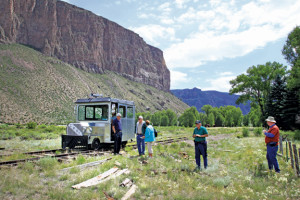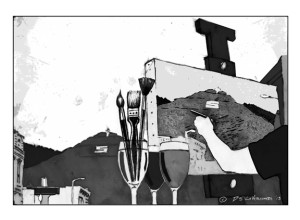By Tina Mitchell
A soft, descending “phew, phew” alerts me to a Mountain Bluebird in the vicinity; a few seconds later, a female zooms to a tree beyond one of the nestboxes I am monitoring. Inside the box, thin strips of juniper bark woven into a sculptural swirl confirm that this is indeed a Mountain Bluebird nest. Using my telescoping mechanic’s mirror to check, I see one lovely, light blue egg. The female eying me probably started laying her clutch earlier today. I quickly close up the box, move away, make a note on my clipboard and head to the next box.
Although most birds raise their young in open nests, some species such as Mountain Bluebirds nest in cavities. Primary cavity nesters, such as woodpeckers, excavate their own cavities. Secondary cavity nesters use naturally occurring cavities or those that have been made, then abandoned, by primary cavity nesters – or human-provided nestboxes. In the piñon/juniper habitat in western Fremont County, our nestboxes have hosted seven other species besides Mountain Bluebirds: White-breasted Nuthatch, Juniper Titmouse, Mountain Chickadee, Western Bluebird, Ash-throated Flycatcher, Violet-green Swallow and a rare Northern Saw-whet Owl. If they reside in your area, these species will also consider using a nestbox: Northern Flicker, Black-capped Chickadee, Tree Swallow, House Wren, Bewick’s Wren, House Sparrow and European Starling.
Monitoring nestboxes provides many fascinating and joyful experiences. Babies grow from wrinkled, naked dinosaur look-alikes into fully feathered young birds in a mere two or three weeks. Hardworking parents bring unending quantities of insects to their hungry nestlings, all while vigilantly protecting them from predators and other harms. Every now and then, I stop in the right place at the right time to see nestlings actually launch, tumble or lurch from the safety of the box into the vast world beyond. And I will never forget glimpses of that diminutive Saw-whet Owl with her three adorable nestlings – extraordinary interactions few people ever experience.
I’ve encountered some other interesting things in nestboxes. Once, when I first started checking boxes, I noticed a long pink strand on the outside edge of the nest. I started to pull it out, so that it wouldn’t get tangled around the nestlings. That “strand” turned into a tail as a deer mouse bolted out of the box – with two tiny, furless babies clinging to her. One summer, I heard a loud buzzing when I tapped on a box – not a typical bird sound, so I nervously just moved on. After hearing that buzzing for three weeks, I finally peeked in to see that a queen bumblebee had established a small colony in there. I once found part of a chipmunk leg in a box – no blood, no sign of a struggle, no clue. In the back of an Ash-throated Flycatcher nest after three young had fledged, a perfectly intact fluffy cottontail tail sat amidst the messiness of the well-used nest. One Juniper Titmouse plucked green and purple fuzz off one of our dog’s toys, splashing some bits of color around her nest.
Monitoring nestboxes is not all rainbows and unicorns, though. Last summer’s brutal heat, for example, appeared to kill a clutch of ten-day-old Western Bluebirds, though other nestlings survived in that same area. Occasionally a small mammal or a tree-climbing snake takes eggs or nestlings. If one parent falls prey to the local Cooper’s Hawk who is also trying to feed its growing family, the other parent can’t always care for all of the nestlings and some die in the nest. While some people agonize over any loss, I take a more objective view. Estimates suggest that 75 – 90 percent of all birds that hatch in one year never make it to the next. Such high mortality rates may not seem right or fair, but they are nature’s way. And honestly – if every baby songbird that hatched each breeding season lived to breed the next year, we’d be sweeping songbirds out of our way with every step.
Albert Einstein said, “Look deep into nature, and then you will understand everything better.” For me, nestbox monitoring offers a very deep look into and understanding of one aspect of nature – the good and the bad, the joyous and the sad, the yin and the yang of the natural world around us.
Tina Mitchell watches nature with her human and canine family from their perch in the piñon/juniper habitat of western Fremont County. When she needs to pay the bills, she shows up as a research psychologist on the University of Colorado Anschutz Medical Campus in Aurora.




